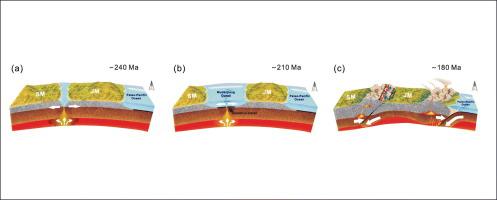当前位置:
X-MOL 学术
›
Gondwana Res.
›
论文详情
Our official English website, www.x-mol.net, welcomes your feedback! (Note: you will need to create a separate account there.)
Opening and closure history of the Mudanjiang Ocean in the eastern Central Asian Orogenic Belt: Geochronological and geochemical constraints from early Mesozoic intrusive rocks
Gondwana Research ( IF 6.1 ) Pub Date : 2020-08-01 , DOI: 10.1016/j.gr.2020.03.003 Xin-yu Long , Wen-liang Xu , Peng Guo , Chen-yang Sun , Jin-peng Luan
Gondwana Research ( IF 6.1 ) Pub Date : 2020-08-01 , DOI: 10.1016/j.gr.2020.03.003 Xin-yu Long , Wen-liang Xu , Peng Guo , Chen-yang Sun , Jin-peng Luan

|
Abstract The tectonic evolution of the ancient Mudanjiang Ocean within the Central Asian Orogenic Belt (CAOB), is strongly debated. The ocean played an important role in the amalgamation of the Songnen and Jiamusi massifs; however, the timings of its opening and closure have remained ambiguous until now. In this study, we analyzed early Mesozoic intrusive rocks from the eastern Songnen and western Jiamusi massifs in the eastern CAOB. The new zircon U Pb ages, Hf isotope data, and whole-rock major and trace element data are used to reconstruct the tectonic evolution of the Mudanjiang Ocean. Zircon U Pb dating indicates that early Mesozoic magmatism in the eastern Songnen Massif occurred in three stages: Early to Middle Triassic (ca. 250 Ma), Late Triassic (ca. 211 Ma), and Early Jurassic (ca. 190 Ma). The Triassic intrusive rocks typically consist of bimodal rock suites, which include gabbros, hornblende gabbros, and granitoids. The compositional information indicates an extensional environment that was probably related to the final closure of the Paleo-Asian Ocean. We integrated the results with observations from Triassic A-type granitoids and coeval sedimentary formations in the eastern Songnen Massif, as well as depositional ages of metasedimentary rocks from Heilongjiang Complex. We conclude that the opening of the Mudanjiang Ocean took place in the Early to Middle Triassic. The Early Jurassic intrusive rocks are bimodal and include olivine gabbros, hornblendites, hornblende gabbros, gabbro diorites, and granitoids. The bimodal rock suite indicates a back-arc style extensional environment. This setting formed in relation to westward subduction of the Paleo-Pacific plate beneath the Eurasia during the Early Jurassic. Following subduction, the closure of the Mudanjiang Ocean and subsequent amalgamation of the Songnen and Jiamusi massifs happened during the late Early Jurassic to Middle Jurassic. This sequence of events is further supported by ages of metamorphism and deformation acquired from the Heilongjiang Complex. Based on these observations, we conclude that the Mudanjiang Ocean existed between the Middle Triassic and Early Jurassic, making it rather short-lived.
中文翻译:

中亚造山带东部牡丹江海的开闭史:早期中生代侵入岩的年代学和地球化学约束
摘要 中亚造山带(CAOB)内古牡丹江洋的构造演化引起了激烈的争论。海洋在松嫩地块和佳木斯地块的合并过程中发挥了重要作用;然而,直到现在,它的开放和关闭时间仍然不明确。在这项研究中,我们分析了中生代东部松嫩地块和佳木斯地块西部的早中生代侵入岩。利用新的锆石U Pb年龄、Hf同位素数据、全岩主微量元素数据重建牡丹江洋构造演化。锆石U Pb定年表明松嫩地块东部早中生代岩浆活动经历了早至中三叠世(约250 Ma)、晚三叠世(约211 Ma)和早侏罗世(约190 Ma)三个阶段。三叠纪侵入岩通常由双峰岩组组成,其中包括辉长岩、角闪辉长岩和花岗岩。成分信息表明可能与古亚洲洋最终闭合有关的伸展环境。我们将这些结果与松嫩地块东部三叠纪A型花岗岩和同期沉积地层的观测结果以及黑龙江杂岩变沉积岩的沉积年龄相结合。我们得出结论,牡丹江海的开放发生在早三叠世至中三叠世。早侏罗世侵入岩是双峰的,包括橄榄辉长岩、角闪长岩、角闪辉长岩、辉长闪长岩和花岗岩。双峰岩组表示后弧型伸展环境。这种环境形成与早侏罗世欧亚大陆下方古太平洋板块向西俯冲有关。俯冲之后,牡丹江海的闭合以及松嫩地块和佳木斯地块的合并发生在早侏罗世晚期至中侏罗世。从黑龙江杂岩体获得的变质和变形年龄进一步支持了这一事件序列。根据这些观察,我们得出结论,牡丹江海存在于中三叠世和早侏罗世之间,因此存在时间较短。从黑龙江杂岩体获得的变质和变形年龄进一步支持了这一事件序列。根据这些观察,我们得出结论,牡丹江海存在于中三叠世和早侏罗世之间,因此存在时间较短。从黑龙江杂岩体获得的变质和变形年龄进一步支持了这一事件序列。根据这些观察,我们得出结论,牡丹江海存在于中三叠世和早侏罗世之间,因此存在时间较短。
更新日期:2020-08-01
中文翻译:

中亚造山带东部牡丹江海的开闭史:早期中生代侵入岩的年代学和地球化学约束
摘要 中亚造山带(CAOB)内古牡丹江洋的构造演化引起了激烈的争论。海洋在松嫩地块和佳木斯地块的合并过程中发挥了重要作用;然而,直到现在,它的开放和关闭时间仍然不明确。在这项研究中,我们分析了中生代东部松嫩地块和佳木斯地块西部的早中生代侵入岩。利用新的锆石U Pb年龄、Hf同位素数据、全岩主微量元素数据重建牡丹江洋构造演化。锆石U Pb定年表明松嫩地块东部早中生代岩浆活动经历了早至中三叠世(约250 Ma)、晚三叠世(约211 Ma)和早侏罗世(约190 Ma)三个阶段。三叠纪侵入岩通常由双峰岩组组成,其中包括辉长岩、角闪辉长岩和花岗岩。成分信息表明可能与古亚洲洋最终闭合有关的伸展环境。我们将这些结果与松嫩地块东部三叠纪A型花岗岩和同期沉积地层的观测结果以及黑龙江杂岩变沉积岩的沉积年龄相结合。我们得出结论,牡丹江海的开放发生在早三叠世至中三叠世。早侏罗世侵入岩是双峰的,包括橄榄辉长岩、角闪长岩、角闪辉长岩、辉长闪长岩和花岗岩。双峰岩组表示后弧型伸展环境。这种环境形成与早侏罗世欧亚大陆下方古太平洋板块向西俯冲有关。俯冲之后,牡丹江海的闭合以及松嫩地块和佳木斯地块的合并发生在早侏罗世晚期至中侏罗世。从黑龙江杂岩体获得的变质和变形年龄进一步支持了这一事件序列。根据这些观察,我们得出结论,牡丹江海存在于中三叠世和早侏罗世之间,因此存在时间较短。从黑龙江杂岩体获得的变质和变形年龄进一步支持了这一事件序列。根据这些观察,我们得出结论,牡丹江海存在于中三叠世和早侏罗世之间,因此存在时间较短。从黑龙江杂岩体获得的变质和变形年龄进一步支持了这一事件序列。根据这些观察,我们得出结论,牡丹江海存在于中三叠世和早侏罗世之间,因此存在时间较短。



























 京公网安备 11010802027423号
京公网安备 11010802027423号